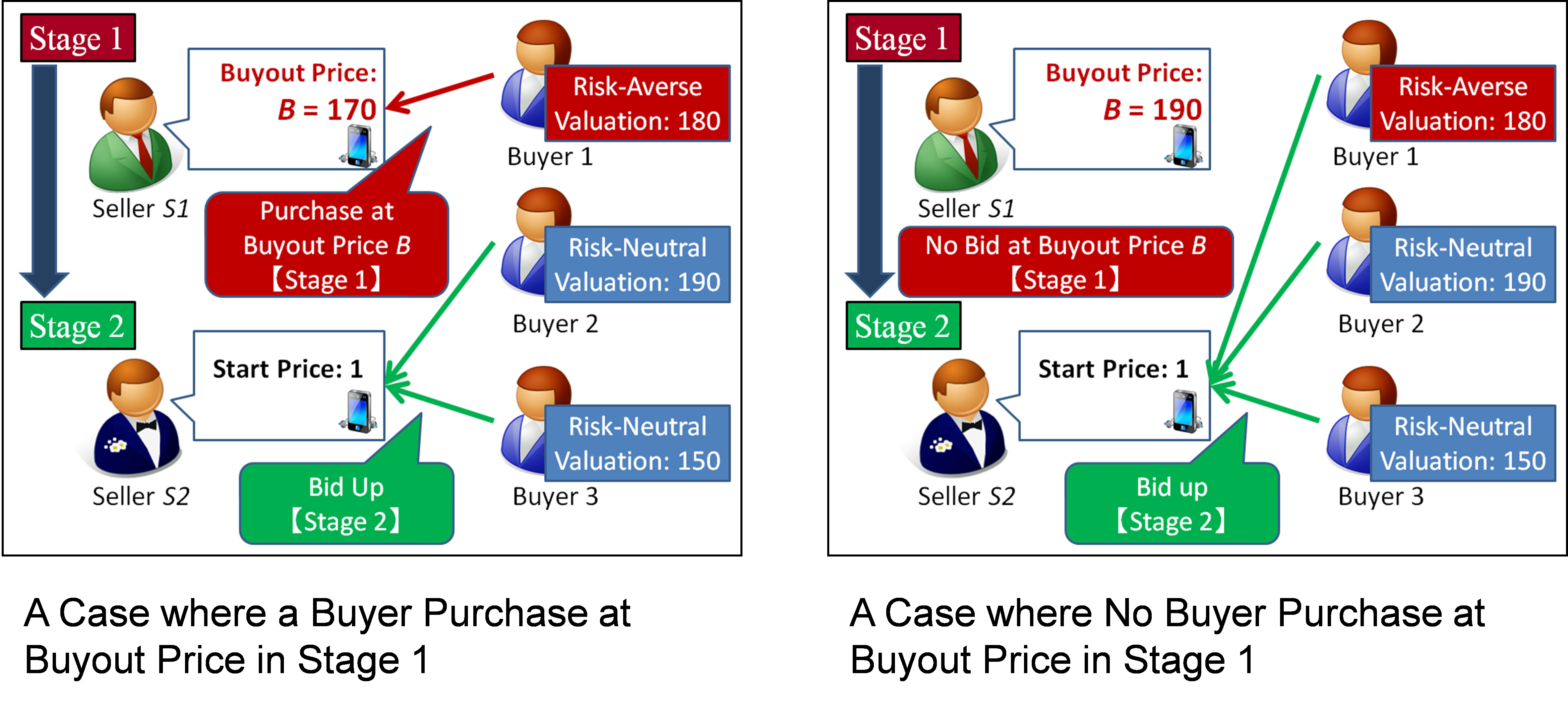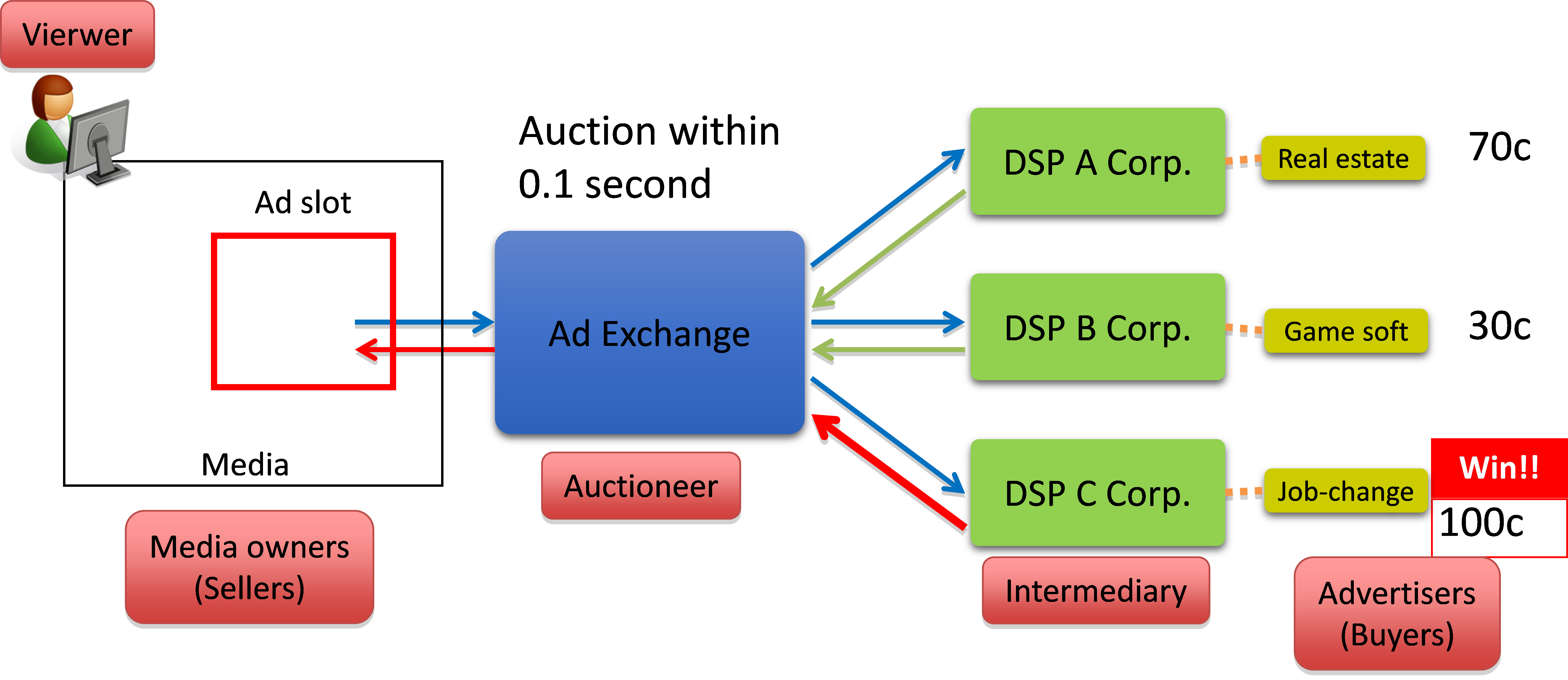Overview
Auctions have been used for trading art objects since old times. Recently, the proliferation of the Internet auctions enables many peoples to sell and buy goods through auctions. Also, auctions are often used in our daily life, e.g., sponsored search auctions decide which sponsor link to be displayed to search engine users. On the other hand, as the system becomes complicated, it becomes difficult for sellers to find the best auction format and for buyers to find the best bidding strategy. According to the proliferation of auctions in the networked society, auctions have been actively studied in the interdisciplinary area including economics (game theory) and computer science. The information economics group in Ishida-Matsubara laboratory aims to develop efficient and safe auction mechanisms by analyzing the real auction data based on the theory of mechanism design.
So far, we have analyzed how the buyout option affects the whole trade in the auction marketplace by analyzing the real auction data provided by Yahoo Japan Corp. Also, we have proposed a bidding method for display advertisement auction by analyzing the real data provided by MicroAd Inc. and employing the market model, which is a technology of multiagent systems.
Research
Analysis of Buyout Options in Internet Auction
The auctions are nothing like what they once were. Some consumers prefer to buy stuff quickly at a fixed price. To meet such a need Internet auction sites offer a buyout option.
Yahoo! JAPAN and uBid provide a permanent buyout option that a fixed-price sale is allowed within an auction while eBay provides a temporary buyout option called “buy-it-now.” If a seller chooses to use a buyout option, shoppers can purchase items at a set price even when the merchandise is also listed in an auction. It has been reported that the buyout-option trades are increasing. Understanding how a buyout option affects the market is significant to design the future auction markets. For sellers, there has been a keen interest in the choice between auctions and fixed-price (posted-price) selling. Previous studies have mainly focused on clarifying the conditions which selling format outperforms. However, researchers have paid little attention to the interaction between two selling formats. In auction sites, identical goods are sold in an auction and at a fixed-price simultaneously.
To investigate the interaction between the two selling formats, we have analyzed the real auction data obtained from Yahoo! JAPAN auction, characterized the typical strategies of the seller, built a model, and carried out a simulation on it. The result of the simulation of the model shows that if the probability that a buyer is risk averse is quite high, both two sellers can benefit by selling a good by using a buyout option and selling another good by using an ascending auction. Thus, we can successfully provide a model able to explain the situation that the two strategies of using ascending auction and fixed-price selling simultaneously exist.
(This research is a joint research with Yahoo Japan Corp.)


- Hiromichi Araki, Shigeo Matsubara and Yuko Sakurai: Analysis of an Internet Auction Market where Ascending Auction and Fixed Price Selling Simultaneously Exist. Web Science Conference 2010 (WebSci’10), Poster Session, Proceedings of the WebSci’10: Society On-Line, WSRI, Raleigh, North Carolina, USA, April 26th, 2010.
A Bidding Strategy as an Intermediary in Advertisement Auctions.
Recently display advertisements, which are a kind of Web advertisements, have been traded by using auctions. Display advertisements are images and/or movies that are embedded in an Web page. Medea owners, slots for displaying advertisements, advertisers correspond to sellers, goods, buyers, respectively. A characteristic of this auction is that an advertiser does not directly place a bid but an intermediary called Demand Side Platform (DSP) places a bid on behalf of the advertiser. A DSP has more than one advertisers as clients and places bids so that the budget constraints of its advertisers should be satisfied. A bidding strategy for this kind of bidders has not been sufficiently examined, although there are many auction studies.
In this research, we build an economic model that the same slot is sold more than one times a day (i.e., multi-unit auction), and an advertisement can be displayed in more than one advertisement slot (i.e., multi-item auction). This model can explain why the fluctuation of winning probability is observed in the real situation. Furthermore, we have employed a market model which is a technology in multiagent systems research and succeeded to propose an efficient bidding method. We evaluated the proposed method by using simulation and showed that the proposed method can increase the number of displaying the advertisement by 30%.
(This research is a joint research with MicroAd, Inc.)

